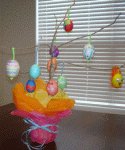
March 10, 2008
As we head into the final quarter of the traditional school year, our mailboxes will soon be filled with catalogs and brochures about homeschooling curriculum. In the March and April issues of Successful Homeschooling, I will walk you through the process of finding the best program for your child.
In This Issue:
- Recognizing Your Child's Gifts
- Creating a Lifestyle of Learning
- Easter Activities
- What's New at Successful Homeschooling
Recognizing Your Child's Gifts
 |
In school, children are given labels like gifted, slow, hyperactive, and learning disabled. However, all children are born with natural gifts and talents, even if they donít thrive under traditional teaching techniques.
As homeschoolers, we can focus on our childrenís strengths, and teach in a manner that helps our children excel. Here are 7 types of intelligence, along with suggestions for making the most of your childís gifts:
- Interpersonal intelligence involves communicating with and understanding others. Children with this gift are great at resolving conflict and working with different personalities. They are social and learn best when interacting with others.
Interpersonal intelligence can also extend to the understanding of animals (such as with a veterinarian or horse whisperer) or nature (such as with a botanist). To capitalize on these gifts, study outdoors and use animal and nature examples when studying other subjects.
- Intrapersonal intelligence involves understanding oneself. These children enjoy being alone, and are often labeled shy and introverted. However, they are typically self-motivated, deep thinkers. They work best on their own, and may not enjoy group projects and activities.
- Kinesthetic intelligence involves bodily movement. It can occur on a large scale (such as with dancers and athletes), or a small scale (such as with craftsmen, typists and seamstresses). Children with this talent learn best while moving, and often get negative feedback in traditional classrooms. Use games and physical activity when teaching these children. Let them express what they have learned in the form of a craft, project or model.
- Linguistic intelligence involves words and language. Children with this talent enjoy reading, writing, vocabulary, word games, speaking, debating, and storytelling. They typically excel with traditional teaching methods.
- Logical intelligence involves numbers, patterns, reasoning and logic. Children with this talent enjoy puzzles, patterns and games of strategy, and can be mathematically gifted. This gift can also manifest as the ability to complete complex mental calculations or analyze angles and acceleration in certain sports. For logically gifted children who donít perform well on textbook exercises, provide plenty of practice with real life math activities.
- Musical intelligence involves rhythm, melody, harmony, music appreciation, singing, and playing instruments. Children with this gift can easily remember information that is put into rhyming format or set to music. They may also prefer listening to music while completing assignments.
- Spatial intelligence involves thinking in pictures or images. Children with this gift may have a photographic memory, and can often rotate an image in their minds to see all sides. Spatially talented children excel at puzzles and mazes. They may enjoy drawing or doodling, and can be great artists and painters and decorators. To help spacially talented children, put information in picture form by using maps, charts and diagrams.
Once you understand your childrenís natural gifts, begin thinking about how they take in and process information. This is known as their learning style.
Our children will learn best when utilizing their strengths. Here is some additional information on choosing a homeschooling method that fits your childís learning style.
Creating a Lifestyle of Learning
 |
Andrew wanted details about their views and how they differed from each other. He wanted to know what their job as president would entail and how it will affect our lives. On a short car ride to take clothes to the drycleanerís, I taught my son the basics of the election process and the executive branch of government Ė all without a textbook.
As the home school curriculum market continues to expand, it is easy to become overwhelmed. Our childrenís education is important to us, and we want to make sure we teach our children everything they need to know.
But as homeschoolers, we must remember that not all learning comes from textbooks, literature programs or even unit studies. Instead of saddling our families with yet another project to check off our to do lists, we can take advantage of opportunities for learning that are present in every day life.
Here are some tips for creating a lifestyle of learning:
- Talk to your children. Our children will learn more about subjects like health and politics from talking to us than they will from filling out blanks in a workbook.
Get into the habit of welcoming conversation from your children, not viewing them as interruptions. Take time to explain information on your childrenís level, and look up answers to questions you donít know.
- Invite your children join you. As you cook dinner, explain why youíre using certain ingredients and how they effect the body - you just taught a lesson in nutrition. As you make your monthly budget, tell your children you have a certain amount of money and youíre deciding what to spend it on - thatís consumer math.
Take your children with you to appointments and meetings. Let them hear you talk about business, family finances and what you read in your favorite magazine. Use life experiences to spark interest, and let the textbooks fill in the details.
- Give your children plenty of downtime. Be careful about filling your day with scheduled projects and activities. Children need time to develop interests of their own. I have watched my son learn symmetry from playing with Kínex and learn double-digit addition from playing basketball.
I no longer wait until a predetermined point on my schedule to teach certain concepts or read books of interest. One of the best ways to facilitate learning is to provide stimulating books and materials, and get out of the way.
Here are some additional ideas for teaching reading, writing and math through the course of daily life. Next month weíll talk about choosing formal curriculum, and preparing for homeschool conventions and curriculum fairs.
Easter Activities
 |
Easter is coming early this year! For the past few years, Iíve had my eye on an Easter Tree from Pottery Barn. This year I found out how to make one on my own. Here are the directions:
Fill an empty container with gravel or sand and insert a large branch. Cover the container with tissue paper, wrapping paper or cloth, and tie with ribbon or string.
Use a toothpick to poke a hole on both ends of an uncooked egg. Insert the toothpick into one of the holes, and twirl it around to break the yolk.
Put your mouth around one end of the egg, and blow the contents of the egg out of the hole on the other end. Rinse the inside of the egg with water so it wonít begin to smell.
Repeat this process for as many eggs as you want to place on your tree.
Dye the eggs, or decorate them with markers, ribbon, paint, yarn, sequins or other items of your choosing.
Tie a knot in one end of a pipe cleaner. Stick the other end through the holes in the egg, and attach it to one of the branches on your Easter Tree.
This tree will make a great centerpiece for your kitchen table.
Here are step by step photos of this and other Easter activities.
What's New at Successful Homeschooling
I finally got around to updating my blog! Check it out for news and information about homeschooling, as well as weekly updates on my familyís adventures.You may have heard by now of the recent California court decision which threatens homeschooling freedom in that state. For more information on the decision and how you can help, visit the Homeschool Legal Defense Association.
As always, if you have been helped by my website or newsletter, please spread the word via e-mail, blog, website, online forums or homeschool groups.
Thank you for subscribing to Successful Homeschooling!
Enjoy the journey,
Carletta